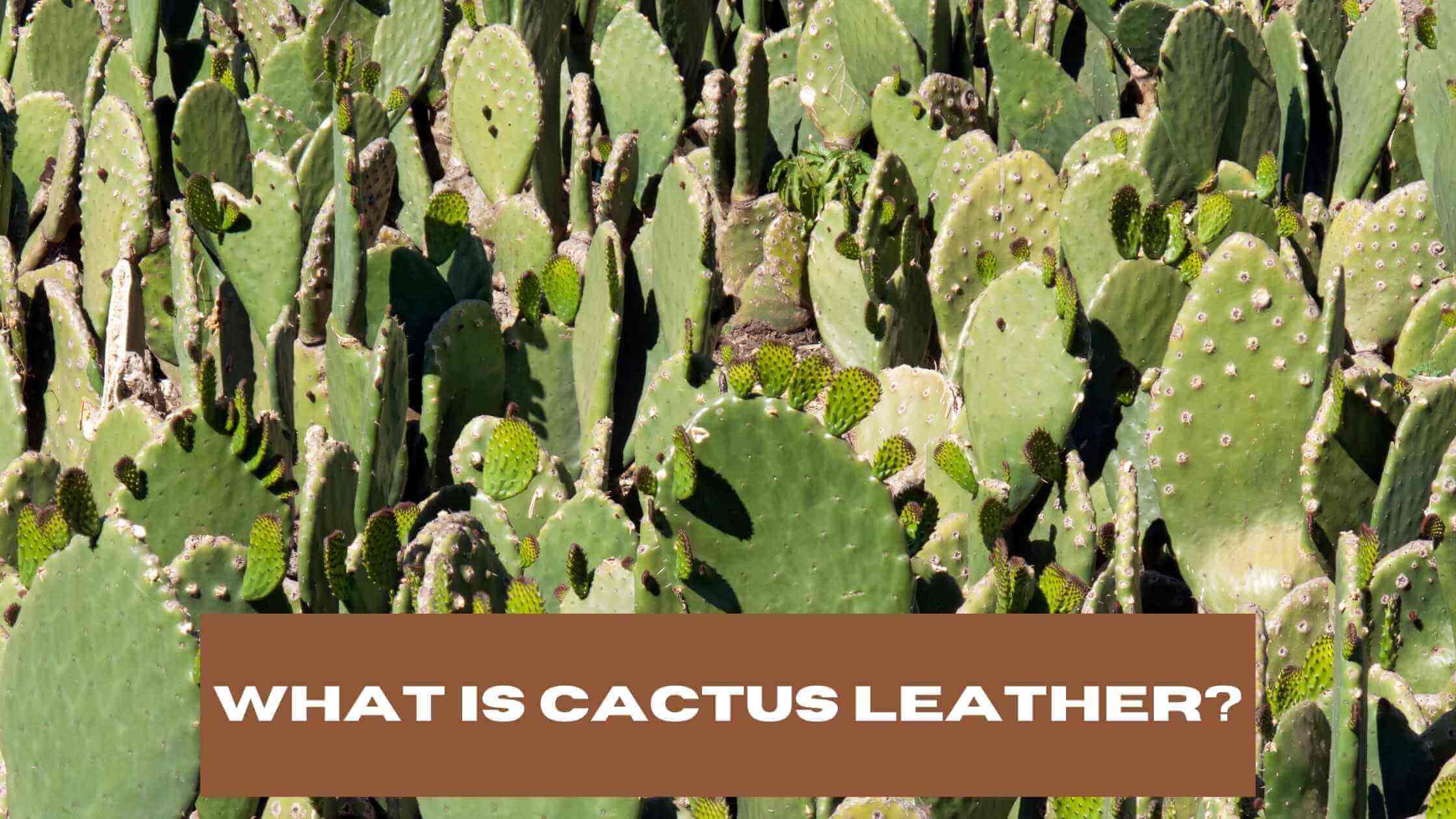Curious about cactus leather and what it actually is compared to classic leather? Here’s what you need to know about this growing alternative leather!
Cactus leather, which is better known as a prickly pear plant, is made from the leaves of a nopal cactus plant. This is a sustainable, vegan, and low-waste alternative to animal leather with perks such as versatility, breathability, durability, and longevity.
While new to the market, it’s quickly and surprisingly getting more popular for many reasons. Read on to find out more!
Is cactus leather real leather?
Cactus leather is not natural leather. It’s considered vegan leather because it doesn’t use any animal skin or byproducts. It has processing (more on that later), but neither animal skin nor animal products are not used at any point.
Cactus leather is different from plastic leather (aka pleather or PU leather), which is made from polyurethane as opposed to traditional animal skin.
Is cactus leather actually vegan leather?
It sounds too good to be true that cactus leather is actually vegan leather, but it’s very much a reality. This is part of what is earning it so much attention from fashion designers and clothing brands worldwide.
While there is a small amount of plastic in vegan leather, it’s significantly lower than in PU leather. It’s still made from organic materials rather than synthetic ones. This is what classifies it as vegan leather; it’s real, organic materials used in leather, but without the use of animal byproducts to do so.
Who invented cactus leather?
Adrián López Velarde and Marte Cázarez discovered the potential for cactus leather and then patented the production process to create what we now see today as cactus leather. Right now, cactus leather is produced only in Zacatecas, Mexico. Their company is named Desserto.
Where can I buy cactus leather products?
If you feel like you’ve never seen cactus leather products before, think again! Many brands shelve this very leather type, including Frida Rome, Kalon, Miomojo, CLAE Shoes, KEVA, and H&M. This list is expected to expand — and quickly — as more classic leather good brands jump on the vegan leather bandwagon.
Cactus leather is one of the most sought-after leather alternatives, even though it initially sounds strange.
Is cactus leather sustainable?
One of the biggest scrutinies over this new market-changing kind of leather is its sustainability. There are many facets of this kind of alternative leather, however, that make it very sustainable. Some of the leading sustainable factors of cactus leather include:
- You can harvest a nopal cactus every 6-8 months
- Harvesting doesn’t damage the plant or its ecosystem
- The nopal cactus is plentiful in Zacatecas, Mexico, and is a perennial
- Manufacturers only need 200L of water during processing (as opposed to over 17, 000L of water for traditional leather manufacturing)
- Cactus leather is partially biodegradable
- The byproduct from the cactus leather is sold to food companies to reduce waste
Cactus leather is a sustainable and minimal waste product from all sides and angles. This gets even better when you learn that it’s also one of the most versatile types of leather in fashion and homeware use. In fact, the Ellen MacArthur Foundation explains that cactus leather can be manufactured into all of your classic leather options (such as shoes, furniture, and wardrobe essentials) without having any noticeable impact on the landscape/ecosystem. You can’t say the same for authentic or PU leather, which takes a lot of time, resources, and waste to produce (comparing it head to head).
Is there plastic in cactus leather?
If you caught on to the mention of plastic above, you already know the answer. Yes, there is a small amount of plastic in cactus leather because it is created by manufacturers combining the cactus leaves with a patented blend of other products to create the leather. While the PU content in cactus leather is significantly lower than any other alternative, it is included in the list of materials used for processing.
How is a cactus made into leather?
Do you need help understanding how cactus leaves are physically formed into the final effect of realistic leather? You’re not alone! After all, it’s better known as “prickly pear,” so how do pointy spines become buttery soft vegan leather?! Here are the steps of the process:
- The cactus grows to maturity without the use of artificial fertilizers
- The cactus is watered naturally with rainwater.
- After harvesting, the leaves are left in the sun to dry out
- The dried leaves are broken down and produced into the “grain” for leather products
You’d be correct if that last bullet point seemed vague. The actual manufacturing process is patented and kept under wraps by Desserto. This is why they are the only manufacturer to date of cactus leather!
However, they quickly release statistics about their manufacturing and production processes. The data and statistics prove to smart and savvy shoppers how sustainable cactus leather is for the environment and the fashion world. Since the fashion world is known for being amongst the worst industries for waste, this is a huge perk.
Desserto assures and proves that no toxic chemicals are used in the manufacturing or production of cactus leather.
Fun Fact: Authentic leather is produced using many hazardous and toxic chemicals. PU leather also uses a lot of dangerous and potentially toxic chemicals.
Is cactus leather soft?
You’ll find that cactus leather is soft and smooth to the touch. This is why you can find it in everything from couches to shoes. It’s often indistinguishable from real leather if you go by touch alone!
Does cactus leather smell?
We understand if you’re specifically looking at leather accessories for the sweet natural leather smell. However, you’re in luck! Life On Mars, a seller of cactus leather, explains that cactus leather smells like classic leather but with an extra hint of sweetness. Could this vegan leather get any better? Actually, yes. Keep reading.
Is cactus leather waterproof?
Cactus leather has dedicated water resistance, unlike authentic leather — which has none. This is because nature organically created the cactus leaves to allow water to run off. This water resistance is passed on via production and manufacturing to the finished leather product! Remember that water resistant doesn’t mean waterproof, so still, take caution when it comes to water and your leather good.
Is cactus leather breathable?
Yes, cactus leather is breathable. This is a strong distinguishing factor from genuine or PU leather. Neither of these more common leather types is breathable.
How long does cactus leather last?
Cactus leather is very tough, and you’ll enjoy approximately ten years with your leather item. Its durability also means it will resist dirt, dust, abrasions, and regular daily life. You won’t need to worry about babying your leather items anymore!
How do you take care of cactus leather?
As a bonus, cactus leather is also very easy to care for. If there is any dirt or debris, you can use a damp cloth with a small amount of mild soap and simply wipe it off. If you have a strong spill of wine or juice, switch out your mild soap for shampoo!
You should never use bleach, oil, vinegar, or detergent cleaners on cactus leather, as it can break down the leather’s integrity. Just because cactus leather is easy to care for doesn’t mean that you can leave dirt and spills indefinitely; the sooner you clean up a blemish or spill, the better the results will be!
Can cactus leather be recycled?
If it’s organic, then you can recycle cactus leather, right? Sort-of. As mentioned, it’s considered partially biodegradable, which means it’s also only partially recyclable. It still does have some plastic in it.
Is cactus leather patented?
Currently, cactus leather is patented by Desserto, and this manufacturer is the only supplier worldwide of cactus leather.
Fun Fact: Desserto doesn’t make leather products. Simply creates the cactus leather in lengths to order and sells it to leather goods manufacturers to produce and sell as vegan leather products.
How much does cactus leather cost?
In most cases, cactus leather should cost about the same as animal leather. However, many interested buyers will find that leather goods made from cactus leather will cost more. This is simply because the demand is very high for cactus leather goods, and the supply is very limited.
Does cactus leather last?
Cactus leather matches and even outperforms a lot of authentic leather goods. Its natural strength means it won’t wear and tear as well-used authentic leather does. This allows it to quickly get 9-10 years of use with minimal care. While it will show wear and tear after ten years, it can continue for longer!
What is cactus leather used for?
While the cactus leather market is limited simply by bottle-necked production, cactus leather itself has endless uses. Currently, it’s used to replace suede items. It’s also used to replace leather jackets, handbags, and briefcases.
As far as furniture is concerned, cactus leather is excellent for car seats and couches. Its natural water resistance is great for small spills, and these seats often get a lot of wear and tear by nature. Unlike classic leather, they’re not as likely to peel or tear over time with use.
Right now, cactus leather is the most popular in footwear. Between its water resistance, durability, and breathability, leather lovers are enjoying the sheer upgrade when choosing between classic leather shoes and cactus leather shoes.
Is cactus leather going to be the future?
Right now, the future of leather is uncertain. Authentic leather gets a lot of heat from animal rights advocates and those against toxic chemicals. PU leather is known for causing hormonal disruptions. Cactus leather is a sustainable and reasonable alternative.
Even today, synthetic leather is overcoming authentic leather for those reasons and others. This is only expected to rise as more and more people learn about it and popular leather brands try to get a piece of the action.
Fun Fact: This essay predicts that synthetic leather production will be worth more than $85 billion by 2025.
Many fashion leather lovers firmly believe that cactus leather will be one of, if not the leading synthetic leather in only several years. Since sustainable and eco-friendly products are now standard in the marketplace, cactus leather can quickly take its rightful place alongside others.
Cactus leather is made from the leaves of the nopal cactus plant. It’s produced in Zacatecas, Mexico using a patented manufacturing process. It’s a sustainable, eco-conscious, durable, cruelty-free, and non-toxic alternative to traditional and synthetic leather products. While its market reach is somewhat small due to limited production, it’s taking the world by storm.
Know someone who loves vegan leather and wants to know what’s new and popular in the marketplace? Please send this to them and see what they think about how it’s forever changing the leather world!

